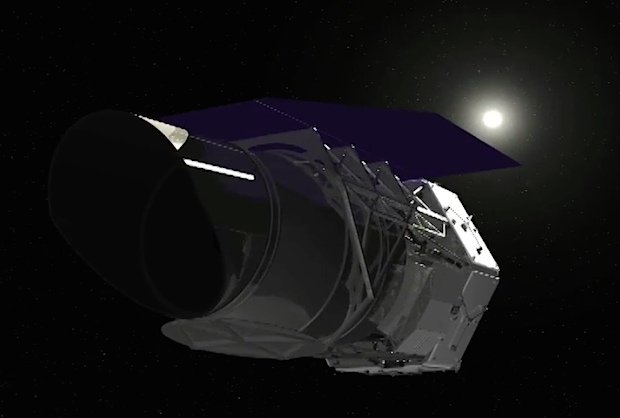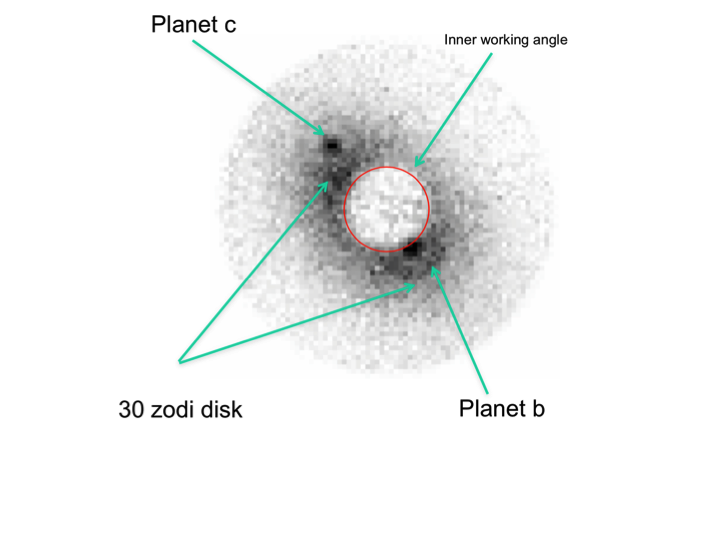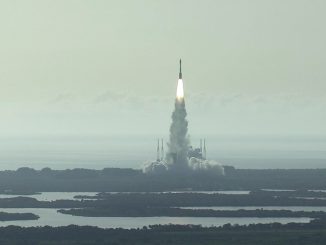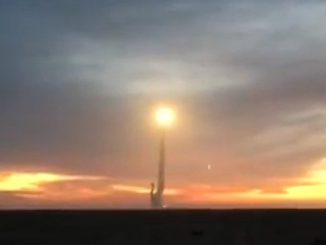
NASA has formally approved plans — a year ahead of schedule — for an infrared space telescope launching around 2024 to record unique wide-angle views of the cosmos, seeking answers to questions about mysterious dark energy and searching for habitable worlds around other stars, the space agency announced Thursday.
The Wide-Field Infrared Survey Telescope is projected to cost approximately $2.3 billion and should operate for at least six years. Its observing post is baselined to be at the L2 Lagrange point, a gravitationally neutral location nearly a million miles from Earth in the direction away from the sun.
WFIRST’s centerpiece is a 7.9-foot (2.4-meter) telescope originally built to allow U.S. intelligence officials to spy on adversaries. Instead of turning the powerful telescope toward Earth for a clandestine surveillance mission, NASA plans to repurpose the hardware for cosmic research.
The National Reconnaissance Office, the U.S. government agency responsible for spy satellites, donated two telescope units to NASA in 2012. The spy organization’s gift to NASA did not include other costly items required for a space mission, such as detectors, a spacecraft and a launcher.
NASA decided to use one of the telescopes for WFIRST, an observatory that was already under discussion when the NRO gave the equipment to the space agency.
Scientists recommended such a mission to NASA in a decadal survey report in 2010, but the surprise availability of the spy optics allowed designers to double the size of WFIRST’s telescope, giving the next-generation observatory vision comparable to the Hubble Space Telescope.
But WFIRST has one advantage over Hubble: It will see a swath of the sky 100 times larger than NASA’s current flagship observatory.
“Telescopes generally come in two different flavors: Really powerful, big telescopes that see a tiny part of the sky, or telescopes that are smaller — so they lack that power — but they can see big parts of the sky. WFIRST is the best of both worlds,” said Jason Kalirai, an astronomer at the Space Telescope Science Institute.
The new observatory is NASA’s next flagship-class, multibillion-dollar astronomy mission after the James Webb Space Telescope due for liftoff in 2018. With spending on JWST declining as it nears launch, NASA’s budget now has room to take on the start of a new astrophysics project.
Wednesday’s decision to officially make WFIRST a NASA mission was expected. Agency officials in January said WFIRST would be formally approved for development this year, and not in 2017 as previously planned, after Congress appropriated extra funding for the project over the last three years.
WFIRST will see the cosmos in near-infrared wavelengths, overlapping with a segment of of the spectrum observed by Hubble and JWST, which is even more sharp-eyed in narrow vision than WFIRST.
NASA officials approved the first stage of WFIRST’s development in a meeting Wednesday, a milestone that officially adds the infrared surveyor to the agency’s mission portfolio.
“WFIRST has the potential to open our eyes to the wonders of the universe, much the same way Hubble has,” said John Grunsfeld, astronaut and associate administrator of NASA’s science mission directorate, in a press release. “This mission uniquely combines the ability to discover and characterize planets beyond our own solar system with the sensitivity and optics to look wide and deep into the universe in a quest to unravel the mysteries of dark energy and dark matter.”
Scientists plan to install two instruments aboard WFIRST — a coronagraph and a wide field instrument — and use the telescope’s observations to directly image planets around other stars and study the effects of dark energy and dark matter on the universe.
Dark energy is a mysterious force accelerating the expansion of the universe.
“WFIRST will allow us to potentially make groundbreaking discoveries in finding out what dark energy is,” said Yun Wang, a senior research scientist at the California Institute of Technology. “So this will tell us if dark energy is an unknown form of energy, or if it’s a modification of general relativity.”
Astronomers using WFIRST’s wide field-of-view will detect thousands of bright supernovae — a giant explosion at the end of a star’s life — to measure how the rate of the universe’s expansion has changed over time, according to NASA.

Scientists expect WFIRST to find up to 20,000 exoplanets orbiting other stars, building on the planet-hunting capabilities of NASA’s Kepler telescope.
For the first time ever on a space mission, WFIRST will carry a coronagraph to block out the bright light of other stars in the Milky Way galaxy. WFIRST will demonstrate the coronagraph’s performance, which could allow astronomers to directly see faint starlight reflected off of planets lurking near stars.
Direct imaging is a key step toward measuring the structure and composition of exoplanets, and in determining whether the worlds are habitable.
Current technology primarily relies on detecting exoplanets as they pass between their parent star and an observing telescope near Earth. This “transit” technique is used by the Kepler mission, but it limits the amount of information astronomers can learn about the planet, and it only works for planetary systems with worlds serendipitously passing in front of a star’s disk as viewed from Earth.
Scientists will also use a novel imaging technique with WFIRST to find undiscovered worlds as small as a tenth the mass of Earth, giving astronomers data to build a census of exoplanets across the galaxy, and helping them determine how common Earth-like planets might be around other stars.
“What we’re looking for is gravitational microlensing events,” said Scott Gaudi, an exoplanet astronomer at Ohio State University. “These are cases when another star passes through our line-of-sight to a background star, and it makes that background star get a little bit brighter due to the gravity of that foreground star, and that allows us to find planets.”
“In addition to its exciting capabilities for dark energy and exoplanets, WFIRST will provide a treasure trove of exquisite data for all astronomers,” said Neil Gehrels, WFIRST project scientist at NASA’s Goddard Space Flight Center in Greenbelt, Maryland. “This mission will survey the universe to find the most interesting objects out there.”
Email the author.
Follow Stephen Clark on Twitter: @StephenClark1.



